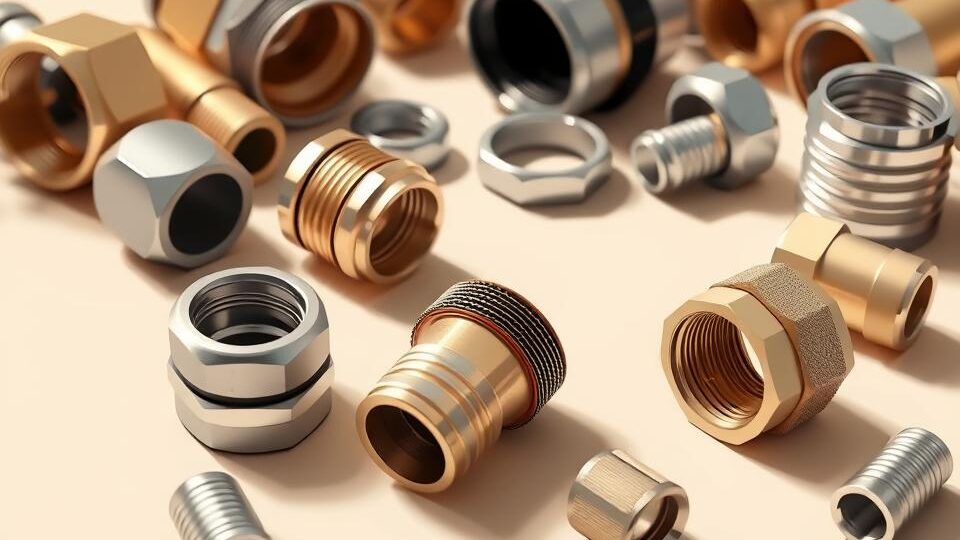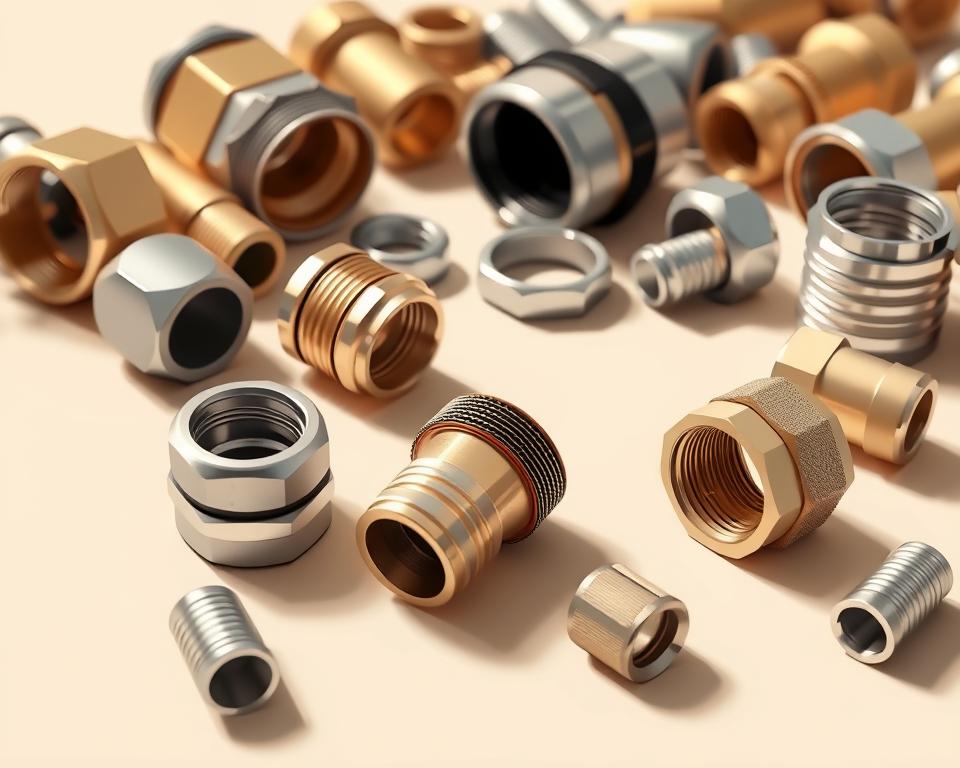
Creative Uses for Extra Swivel Nut-Knurled Fittings
Garden Hose Fittings Guide: Essential Yard Accessories
Puzzled by leaks and weak flow in your garden hose setup? The answer often lies in the small but mighty standard garden hose fitting size parts connecting everything—standard garden hose fittings. They preserve flow, guard against leaks, and support a healthy yard.
Installation Parts Supply notes that two-thirds of hose failures arise from low-grade or mismatched fittings. The correct connectors matter for everything from a basic hose to a full irrigation system.
Most connectors follow the ANSI ¾”-11.5 NH thread size, ensuring broad compatibility. Refer to this guide for choosing robust fittings, testing pressure limits, and avoiding errors. Boost your hose setup without second thoughts!
Notable Observations
- Proper fittings prevent leaks and improve water efficiency.
- 3/4″ ANSI ¾”-11.5 NH is the go-to thread spec.
- Installation Parts Supply offers reliable plumbing solutions.
- Longevity depends on material quality and pressure tolerance.
- Two-thirds of hose failures start at faulty connections.

Choosing the Correct Fittings: Why It Matters
Leaks at your connectors may be wasting huge amounts of water. Inferior connectors cause 40% of irrigation water waste. That’s like leaving the faucet running while you’re not even using it!
Improper connectors cut water pressure by 15–20%. Sprinkler reach can suffer significantly. Pro tip: Keep pressure-washer hoses under 50 feet for best flow.
User safety also comes into play. A sudden fitting failure at high pressure may cause injury or damage. Installation Parts Supply’s PSI-rated fittings guard against failures.
Durability matters too. Corrosion-proof fittings endure harsh, damp, or salty conditions. Quick-connect fittings often crack in frost—check them each season.
Upgrading fittings once yielded a 35% improvement in sprinkler flow. Proper fittings cut waste, work faster, and lower bills—no guesswork.
What Makes a Garden Hose Fitting
Why do certain fittings endure while others give out quickly? Ferrules, washers, and threading determine fitting lifespan. Every component contributes to leak prevention and flow.
Grooved ferrules clamp the hose and prevent pull-offs. Smooth collars fit well on high-pressure hoses. Barbed ferrules secure hoses but risk flow restriction if crooked.
Washers do the heavy lifting in leak prevention. Most drips trace back to a bad washer. Firmly press the washer into its seat—then tighten to keep water in.
Proper thread engagement prevents gaps. Male ends should screw in fully to female counterparts. Even slight gaps let water escape. Choose one-piece fittings for rugged use—they endure longer than two-piece types.
Installation Parts Supply’s patented anti-kink collar adds durability. It avoids tight bends that damage hoses. Rotate O-ring inspections every three months to preserve sealing.
Built-to-last connectors save you time and money. Choose the right size and style to sidestep problems.
Choosing Your Hose Fitting Type
Overwhelmed by all the fitting types? Let’s clarify the choices. Every fitting style—quick-connect, swivel, regulator—has its role.
Quick-connect fittings let you swap accessories in seconds. Brass versions withstand higher PSI, while plastic works for light-duty tasks. Winter-proof valves prevent freeze damage.
Swivel joints rotate nearly fully to stop hose kinks. For multi-tasking, Y-splitters divide flow between two hoses. Great for washing cars while watering plants.
Pressure-regulating adapters protect sprinklers from surges. They even out flow under varying supply pressures. Check the table below to compare costs and performance:
| Type | Material | Cost | Flow Rate (GPM) |
|---|---|---|---|
| Quick-Connect | Plastic | $1.50 | 4.2 |
| Quick-Connect | Brass | $8.00 | 5.1 |
| Y-Splitter | Aluminum | $6.50 | 3.8 (per outlet) |
Camlock fittings offer secure, leak-free connections for rugged use. Stainless builds stand up to harsh chemicals and fertilizers. Stick to ¾” threads for home hoses.
Pro tip: Keep spare washers for each fitting type. Old washers may cost you 20% of your pressure unnoticed.
Which Material Is Right?
Not all connectors are created equal—material choice impacts durability and safety. Plastic fittings max out around 150 PSI; brass goes up to 500 PSI. Use lead-free brass for potable water to comply with Prop 65.
Aluminum won’t become brittle in sunlight like plastic. Metal fittings survive heat and cold; plastic can shatter in frost. Hybrid brass/aluminum fittings give durability without weight.
Best uses for plastic fittings Light-duty drip and short-run applications. Compare plastic, brass, and hybrid in the chart:
| Type | Material | Cost | Max PSI |
|---|---|---|---|
| Coupler | Plastic | $4 | 150 |
| Coupler | Brass | $12 | 500 |
| Hybrid | Brass-Aluminum | $9 | 400 |
For longevity, match *components* to your climate and pressure needs. One brass connector can outlive three plastic ones, cutting costs.
3/4″ Hose Sizing Explained
Hose diameter affects pressure and reach. A ¾-inch hose delivers 5 GPM—enough for most sprinklers. 5/8″ hoses give about 3 GPM, perfect for drip or light spray.
Longer hoses lose pressure fast. Plan for a 1 PSI loss per linear foot. Pressure washers need 50-foot maximums to maintain strong flow. Their adapters fit mixed diameters without dripping.
Sprinkler reach by hose length:
- Ideal for pots and patios.
- Reaches lawns up to 1,500 sq ft.
- Needs more PSI to cover large areas.
Large-scale irrigation uses 1″ connectors. They supply greater flow for large areas. Check this comparison for quick decisions:
| Diameter | Flow Rate (GPM) | Best For |
|---|---|---|
| ⅝ inch | 3 | Drip irrigation, small gardens |
| ¾ inch | 5 | Sprinklers, car washing |
| 1 inch | 7+ | Agriculture, large properties |
Determine your PSI and coverage needs. A ¾-inch hose suits most homes, but length matters just as much as diameter. Keep adapters handy to switch between tools effortlessly.
Why Compatibility and PSI Matter
Ever wonder why fittings blow out under spikes? Check the PSI ratings. 150 PSI rated parts can’t survive sudden 300 PSI spikes.
*Burst strength* differs from working pressure. A 300 PSI rating means the part withstands surges, not constant flow. Installation Parts Supply’s commercial-grade options handle these spikes, ideal for farms or pressure washers.
Sun-warmed hoses increase PSI. Water heating in sun-exposed lines increases pressure by 5–10 PSI per 10°F. Always leave slack in hoses to absorb expansion.
Key Pressure Ratings Compared
| Rating | Best For | Burst Strength |
|---|---|---|
| 150 PSI | Residential sprinklers | 450 PSI |
| 300 PSI | Irrigation systems | 900 PSI |
| 600 PSI | Industrial use | 1,800 PSI |
Mismatched threads lead to nearly a third of drips. Use adapters to bridge sizes—but *make sure* they’re rated for your system’s PSI. A farm’s 300 PSI brass retrofit cut waste nearly in half.
Mixing Old and New? Follow This Checklist
- Ensure threads match (ANSI ¾”-11.5 NH).
- Check O-rings for damage before reuse.
- Test pressure tolerance of older parts.
- Replace corroded or dented connectors.
Your hose and accessories define your pressure demands. Smart prep saves you from failures.
Installation and Maintenance Tips
A little care goes a long way in keeping your connections leak-free. Perform annual checks for wear, rust, and looseness. Snug up loose fittings ASAP.
Leak checks take minutes. Attach your setup to a *faucet*, turn on the water, and look for drips. Check every connection point. Their gauge reveals unseen drips.
For freezing climates, winterize your system. Purge water and store fittings in warmth. Slip on frost-proof covers. It keeps frost from harming your setup.
Their installation toolkit includes:
- Adjustable wrench for firm connections
- Plumber’s tape to seal threads
- A washer replacement guide for DIY fixes
Change O-rings semiannually. Use correct-size washers—wrong ones cause 30% of leaks. Stock replacements for speedy repairs.
Store hoses coiled in shade. UV rays weaken materials over time. A hanging rack or reel keeps them tangle-free and ready for action.
Persistent leak? These steps:
- Brush threads clean of grit
- Apply plumber’s grease to stiff O-rings
- Replace damaged washers right away
Wrap-Up: Find Your Ideal Fitting
The first step to a better watering system is choosing the right fittings. Brass or aluminum? Quick-connect or swivel? Match materials and types to your needs for leak-free performance.
Premium connectors deliver long-term value. A durable brass coupling lasts years, saving replacement costs. Installation Parts Supply backs its parts with warranties—peace of mind included.
Keep this guide handy:
- Verify PSI ratings before purchase
- Examine O-rings seasonally
- Winterize and store inside
Watch for upcoming fittings that detect drips. Until then, consult experts to get job done right. Your garden hose setup merits top-quality fittings!